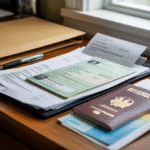Driving License Application Form: Everything You Need to Know in the UK
Driving license application form is the cornerstone of any process related to obtaining, renewing, or updating a driving license in the United Kingdom. Whether you’re a teenager excited about your first provisional license, a seasoned driver renewing your photocard, or a professional applying for a vocational license, understanding the ins and outs of this essential document is the first step toward legal driving.
This article provides a detailed breakdown of the driving license application form, including where to get it, how to complete it, who needs it, what supporting documents are required, and how to avoid common mistakes. We’ll also explain the various types of forms available and outline the latest procedures in 2025.
Why the Driving License Application Form Is Essential
The driving license application form serves as the legal document for requesting authorization to drive vehicles on UK roads. It captures your personal information, verifies your eligibility, and ensures compliance with health, identity, and residency standards. Without this form, the DVLA (Driver and Vehicle Licensing Agency) cannot process your application for a provisional, full, or commercial driving license.
In addition, the form acts as a gatekeeper—ensuring only qualified and responsible individuals are issued a license. This helps uphold road safety, insurance compliance, and public trust in the UK’s transport system.
Who Needs a Driving License Application Form?
You’ll need to complete a driving license application form in the following situations:
- First-Time Drivers: Applying for a provisional license at age 15 years and 9 months or older.
- Upgrading a License: Converting a provisional license to a full license after passing your driving test.
- Vocational or Professional Drivers: Seeking a D2 or D4 form for lorries, buses, and other commercial vehicles.
- Lost or Stolen License Replacement: Requesting a new license if yours is lost, stolen, or damaged.
- Photocard Renewal: Renewing your license if it’s expired or nearing expiry.
- Medical Declarations or Name Changes: Updating your license after a name change or health condition update.Driving license application form
Different Types of Driving License Application Forms
The DVLA issues several types of forms depending on the purpose of your application:
- D1 Form – For applying for a car or motorcycle driving license (provisional or full).
- D2 Form – For applying for lorry, minibus, or bus licenses.
- D4 Form – Medical report for drivers applying for vocational licenses.
- D798 – Used for photocard renewals.
- V62 – If you need a replacement for a lost, stolen, or damaged license.
Each form has its own criteria and sections, and the type of form you require depends on your specific application.Driving license application form
Where to Get a Driving License Application Form
You can obtain a driving license application form through several convenient channels:
1. Post Office
You can collect D1 and D2 forms at most UK Post Office branches. They are provided free of charge and come with instructions for completion.
2. DVLA Website
While the full D1 and D2 forms cannot be downloaded, you can request a copy by mail via the DVLA’s official website. Many updates, like changing your address, can be completed online without a paper form.Driving license application form
3. By Phone
You can call the DVLA to order a form. This is useful if you have specific needs or can’t visit a Post Office branch.
How to Complete the Driving License Application Form
Completing the driving license application form accurately is crucial to avoid delays or rejections. Here’s a step-by-step guide:
Step 1: Gather Required Documents
Depending on your application type, you may need:
- Proof of identity (e.g., valid UK passport, birth certificate)
- National Insurance number
- Passport-style photo
- Payment method
- Medical documents (if applicable)
Step 2: Fill in the Form
Read all instructions carefully and complete every relevant section. Typical fields include:
- Full name and address
- Date of birth
- Previous addresses (for the past 3 years)
- Medical and eyesight declaration
- Signature
Use block capitals and black ink if completing a paper form.
Step 3: Check for Errors
Ensure all fields are completed correctly. Incomplete or incorrect forms are one of the leading causes of DVLA delays.Driving license application form
Submitting the Application
Once the form is completed:
For Postal Applications
Send the form and documents to:
DVLA, Swansea, SA99 1BN
Include any required fee via cheque, postal order, or card details.Driving license application form
For Online Applications
Where permitted, you can submit applications directly through the GOV.UK portal, which is faster and often cheaper than the paper method.Driving license application form
Application Fees
The cost of submitting a driving license application form varies depending on the type of service:
- Provisional license (online) – £34
- Provisional license (by post) – £43
- Photocard renewal – £14 (online) or £17 (post)
- Lost/stolen replacement – £20
You can pay online by card or include payment with your posted application.
How Long Does It Take?
Processing time depends on the method of submission:
- Online applications: Usually processed within 1 week.
- Postal applications: Can take up to 3 weeks.
- Vocational licenses or medical reviews: May take longer due to assessments and documentation.
Always allow extra time if your application includes a medical disclosure or identity verification.Driving license application form
Common Mistakes to Avoid
To avoid unnecessary delays, keep the following tips in mind:
- Missing Documents: Always include originals of required documents, such as a passport or birth certificate.
- Outdated Photos: Your photo must be recent and meet passport standards.
- Incomplete Information: Fill in every applicable section of the form.
- Unsigned Form: Your signature is legally required.
- Incorrect Payment: Ensure you include the correct fee in the proper format.
What Happens After Submission?
Once your driving license application form is received, the DVLA will review your details. If all is in order:
- A provisional or full license will be mailed to your address.
- For online applications, a confirmation email will be sent.
- If any problems are found, such as unclear identity or health issues, the DVLA will contact you for clarification.
Tracking Your Application
If you’ve applied online, you can track your application using your DVLA reference number. For postal applications, you can contact the DVLA after 3 weeks if your license hasn’t arrived.
Additional Tips for 2025 Applicants
As of 2025, some new practices and digital services have been implemented by the DVLA to streamline licensing procedures:
- Digital ID Verification: Some applicants can now use GOV.UK’s Verify service to confirm identity without sending physical documents.
- Online Medical Declarations: Many health conditions can now be reported online using secure forms.
- Digital Provisional Licenses: A beta program is underway allowing provisional drivers to use a digital license on mobile devices.
Final Thoughts
The driving license application form is your gateway to legally driving in the UK. Understanding which form you need, how to complete it correctly, and where to submit it will help you avoid common pitfalls and ensure a timely response from the DVLA.
Whether you’re a young driver just starting out, or an experienced motorist renewing your details, this guide provides all the essential information you need to complete your application with confidence.





